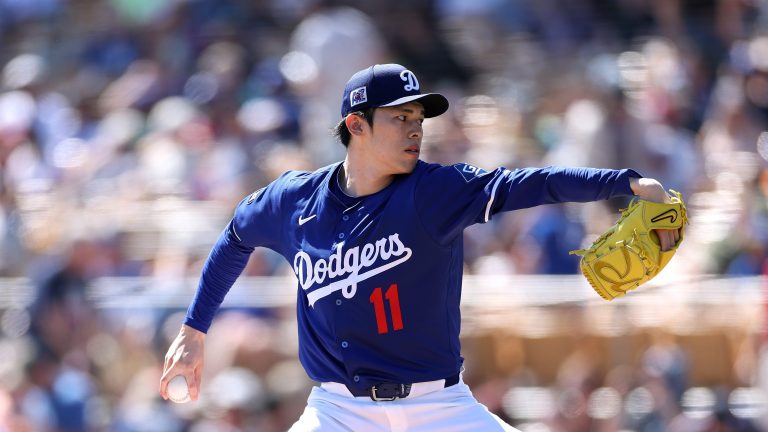What Can We Draw From Roki Sasaki’s First Five Starts for the Dodgers?
Effective but uneven. Five starts in, the Dodgers’ rookie phenom is surviving, but the underlying numbers raise real concerns.

When the Los Angeles Dodgers won the sweepstakes for Roki Sasaki this offseason, they landed the prized international arm of the offseason and a generational young talent. The 23-year-old entered MLB with immense expectations, immediately becoming one of the sport’s top prospects.
Sasaki arrived with a fastball that can touch 102 mph, a gyro splitter dubbed the “Dragon Fork” and the aura of a phenom forged in Nippon Professional Baseball (NPB) and burnished by his 2023 World Baseball Classic display.
Now, five starts into his MLB career, the evaluation of his performance is complex. The results haven’t been discouraging, but certainly illuminating, and far from definitive. For all the hype, all the YouTube montages, all the comparisons to Darvish, Tanaka, Ohtani, and Yamamoto, Sasaki is very much a work in progress.
His 3.20 ERA across 19.2 innings looks solid, but peel back the surface, and you find a 5.32 expected ERA (xERA), 16 walks and a bumpy ride underneath the hype. What’s clear is that Sasaki is electric but imperfect.
Let’s unpack the underlying data regarding his stuff, command, workload management and developmental pacing.
Stats, rankings, and percentiles updated prior to first pitch on April 25.
A Diminished Fastball: From Triple-Digit Heater to Trouble Spot
Sasaki’s four-seamer, and the heavy split-finger playing off of it, is what made scouts salivate. In 2023, his fastball was a triple-digit monster that carved up NPB hitters and struck the World Baseball Classic radar gun at 102 mph.
In 2024, though, concerns mounted, as his fastball velocity dipped to an average of 97 mph, and he lost some of the late ride that made the pitch so devastating. Sasaki only managed 202 innings pitched over his final two NPB seasons, and reports of shoulder fatigue surfaced.
Part of each MLB team’s pitch to Sasaki was how they could help him mechanically so he could reach and sustain his pre-2024 heights.
Of course, a lengthy adjustment period to the MLB baseball itself was to be expected. The MLB ball is bigger and slicker than the NPB baseball, making it more difficult to grip, manipulate and spin.
So far in MLB, Sasaki’s fastball has averaged 96.5 mph, ranking in the 84th percentile league-wide in velocity. More concerning than the velo dip is what hitters are doing to the pitch:
- Expected Batting Average (xBA): .330
- Expected Slugging (xSLG): .612
- Hard-Hit Rate: 57.5%
- Whiff Rate: 16.7%
The shape and location of the pitch has been inconsistent, particularly when elevated. It’s being punished, and its struggles to tunnel effectively with the splitter are undermining its effectiveness.
Why the Struggles: Mechanical Tweaks, Fatigue, or Strategic Load Management?
Mechanics? Transition? Fatigue? Load Management? Possibly all four.
The velocity drop-off in Sasaki’s most recent start last Saturday against the Rangers in Texas (93.8 mph average) was stark; it came in nearly 3 mph below his season average. Sasaki has been throwing 100+ since high school. He’s wiry, athletic and still building durability.
Given his short track record of just 394 ⅔ pro innings before MLB, the Dodgers may be working with him to recalibrate mechanics and prioritize health over heat.
With Tony Gonsolin and Blake Snell already missing time, Clayton Kershaw still working his way back, several other pitchers shelved for the season, and Yoshinobu Yamamoto carrying a heavy burden, the Dodgers need Sasaki’s development to continue, with durability intact.
Whether he and the Dodgers are making conscious adjustments mid-season or if these are signs of fatigue or mechanical disconnect is unclear. For now, it’s something to flag for the Dodgers’ high-performance team, and it will be a storyline to watch closely in May and June.
The Splitter Has Translated
Sasaki throws his nasty splitter 30.5% of the time, averaging 85 mph, with late vertical drop and arm-side fade that’s made big leaguers look silly at times:
- Whiff Rate: 45.7%
- Putaway %: 19.1%
- Opponent BA: .118
- Avg Launch Angle: 15°
Sasaki is using the splitter as his out pitch, letting it fade out and down to lefties and burying it on righties. But in some at-bats, particularly those when his fastball command eludes him, it’s been the only offering he can rely on to generate soft contact or swings and misses.
As he adjusts to the MLB ball, he may begin leaning on it more as a strike-getter, not just a whiff weapon.
Command and Control: A Work in Progress
Sasaki’s biggest battle so far has been controlling the zone. Sixteen walks in 19.2 innings is not sustainable; his 18.6% walk rate is more than double the league average (9.1%).
The early jitters (five walks in his debut vs. the Cubs in Tokyo) seem to be tapering, as he has walked just five batters over his last two starts.
Encouragingly, he’s also starting to pitch deeper into games, logging five innings of one-run ball in start four and six innings of two-run ball in start five. That’s a promising sign for a pitcher still adjusting to the rhythm and workload of the MLB schedule.
Still, Sasaki is struggling to consistently land his slider or fastball for early strikes. His first-pitch strike rate is just 55.8%, below the league average of 61.3%. Mechanically, the inconsistency seems rooted in timing. He has a unique lower-half move, with a deep hip hinge and high front leg lift. When that timing is even slightly off, his release point wavers, especially glove-side.
Sasaki hasn’t been shelled, far from it. And while he isn’t racking up strikeouts, he’s showing some poise, learning in real-time how to navigate MLB lineups.
A Shaky Slider, and the Need for a Fourth Offering
The third pitch in Sasaki’s current mix is a slider at 82.3 mph, thrown 16.6% of the time. It’s far from a finished product. Hitters are whiffing (44.4%), but they are not chasing (17.1%), and he has struggled to land the pitch for strikes.
Without a reliable breaking ball, Sasaki is mostly stuck in a 1-2 combo – fastball/split – that only works if his fastball is elite. It hasn’t been. In Japan, Sasaki didn’t need a fourth pitch. In MLB, he will.
Contact Quality, Defense, and Some Luck
Sasaki has benefited from some fortunate sequencing and defense:
- Batters are slugging just .267 off him, but the expected slugging sits at .478.
- Opponents have barreled him up 5 times on 54 batted balls (9.3% compared to a league barrel average of 7%).
- 46.3% of batted balls off him have been hit 95+ mph (MLB average: 36.6%).
The Rangers, in particular, smoked him. In his latest outing, nine balls off Sasaki were hit at 95+ mph, including a 110-mph laser from Adolis García that landed in a shifted infielder’s glove. Yet, Sasaki only surrendered two runs on two hits.
His average exit velocity allowed is 91 mph, his groundball rate is just 42.6% and his whiff rate is just 23.3%. That’s surprising for someone with his raw stuff. But part of the issue is that he’s not sequencing well, and the 5.32 xERA is a product of that, tied to the fastball’s ineffectiveness and bouts of erratic command.
Yet, he’s held hitters in check: Righties are hitting just .200, lefties .171. Until Michael Busch homered in start four, Sasaki had held hitters to 47 straight plate appearances without an extra-base hit.
Roki Sasaki Is An Incomplete Monster

The Dodgers didn’t sign Sasaki to be an immediate Cy Young contender. They signed him for what he could become, and in flashes, he’s shown exactly that.
The strikeout totals will climb once the slider becomes a more reliable offering. The fastball will either find its shape or get de-emphasized in favor of a heavier splitter-cutter mix. The command, while erratic, is trending in the right direction.
Sasaki is one of the most hyped arms to come from Japan for good reason. He’s young, freakishly talented and surrounded by some of the smartest pitching minds in baseball. There will be bumps, and maybe some skipped starts or planned downticks in usage.
But nothing so far suggests Sasaki is anything less than a foundational piece for the Dodgers’ rotation for years to come.
And five starts in? That’s exactly what you’d hope to see: not dominance, but growth.
The Monster of the Reiwa Era is still just getting started.
